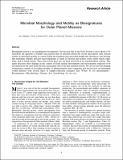Microbial Morphology and Motility as Biosignatures for Outer Planet Missions
Author(s)
Nadeau, Jay; Lindensmith, Chris; Deming, Jody W.; Stocker, Roman; Fernandez, Vicente Ignacio
DownloadNadeau-2016-Microbial Morphology.pdf (1.033Mb)
PUBLISHER_CC
Publisher with Creative Commons License
Creative Commons Attribution
Terms of use
Metadata
Show full item recordAbstract
Meaningful motion is an unambiguous biosignature, but because life in the Solar System is most likely to be microbial, the question is whether such motion may be detected effectively on the micrometer scale. Recent results on microbial motility in various Earth environments have provided insight into the physics and biology that determine whether and how microorganisms as small as bacteria and archaea swim, under which conditions, and at which speeds. These discoveries have not yet been reviewed in an astrobiological context. This paper discusses these findings in the context of Earth analog environments and environments expected to be encountered in the outer Solar System, particularly the jovian and saturnian moons. We also review the imaging technologies capable of recording motility of submicrometer-sized organisms and discuss how an instrument would interface with several types of sample-collection strategies. Key Words: In situ measurement—Biosignatures—Microbiology—Europa—Ice.
Date issued
2016-08Department
Massachusetts Institute of Technology. Department of Civil and Environmental EngineeringJournal
Astrobiology
Publisher
Mary Ann Liebert, Inc.
Citation
Nadeau, Jay; Lindensmith, Chris; Deming, Jody W.; Fernandez, Vicente I. and Stocker, Roman. “Microbial Morphology and Motility as Biosignatures for Outer Planet Missions.” Astrobiology 16, no. 10 (October 2016): 755–774 ©2012 Mary Ann Liebert, Inc. publishers
Version: Final published version
ISSN
1531-1074
1557-8070